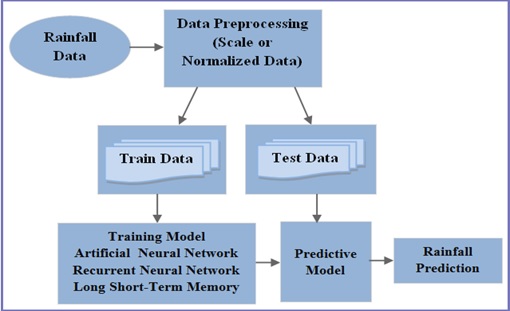Rainfall Analysis and Forecasting Using Deep Learning Technique

DOI:
https://doi.org/10.54060/JIEEE/002.02.015Keywords:
Rainfall Prediction, Deep Learning, ANN, RNN, Long Short-Term MemoryAbstract
Rainfall forecasting is very challenging due to its uncertain nature and dynamic climate change. It's always been a challenging task for meteorologists. In various papers for rainfall prediction, different Data Mining and Machine Learning (ML) techniques have been used. These techniques show better predictive accuracy. A deep learning approach has been used in this study to analyze the rainfall data of the Karnataka Subdivision. Three deep learning methods have been used for prediction such as Artificial Neural Network (ANN) - Feed Forward Neural Network, Simple Recurrent Neural Network (RNN), and the Long Short-Term Memory (LSTM) optimized RNN Technique. In this paper, a comparative study of these three techniques for monthly rainfall prediction has been given and the prediction performance of these three techniques has been evaluated using the Mean Absolute Percentage Error (MAPE%) and a Root Mean Squared Error (RMSE%). The results show that the LSTM Model shows better performance as compared to ANN and RNN for Prediction. The LSTM model shows better performance with mini-mum Mean Absolute Percentage Error (MAPE%) and Root Mean Squared Error (RMSE%).
Downloads
References
Y. Dash, S. K. Mishra, and B. K. Panigrahi, “Rainfall prediction for the Kerala state of India using artificial intelligence approaches,” Comput. Electr. Eng., vol. 70, pp. 66–73, 2018.
T. Kashiwao, K. Nakayama, S. Ando, et al., “A neural network-based local rainfall prediction system using meteorological data on the Internet: A case study using data from the Japan Meteorological Agency,” Appl. Soft Comput., vol. 56, pp. 317–330, 2017.
S. Nurcahyo, F. Nhita and Adiwijaya, "Rainfall prediction in Kemayoran Jakarta using Hybrid Genetic Algorithm (GA) and Partially Connected Feedforward Neural Network (PCFNN)," 2nd International Conference on Information and Communication Technology (ICoICT), pp. 166-171,2014.
Y. Dash, S. K. Mishra, and B. K. Panigrahi, "Rainfall prediction of a maritime state (Kerala), India using SLFN and ELM techniques," 2017 International Conference on Intelligent Computing, Instrumentation and Control Technologies (ICICICT), pp. 1714-1718, 2017.
P.S. Dutta, & H. Tahbilder,” Prediction of rainfall using data mining technique over Assam,” Indian Journal of Computer Science and Engineering (IJCSE), vol.5, no.2 pp.85-90,2014.
A. Haidar and B. Verma, "Monthly Rainfall Forecasting Using One-Dimensional Deep Convolutional Neural Network," in IEEE Access, vol. 6, pp. 69053-69063, 2018.
C. Thirumalai, K. S. Harsha, M. L. Deepak, et al., "Heuristic prediction of rainfall using machine learning techniques," International Conference on Trends in Electronics and Informatics (ICEI), pp. 1114-1117, 2017.
A. Kala and S. G. Vaidyanathan, "Prediction of Rainfall Using Artificial Neural Network, “International Conference on Inventive Research in Computing Applications (ICIRCA), pp. 339-342,2018.
P. Zhao, M. Zhang, M. Qiu et al., "A Short-Term Rainfall Prediction Model Using Multi-task Convolutional Neural Networks," 2017 IEEE International Conference on Data Mining (ICDM), pp. 395-404, 2017.
R. I. Rasel, N. Sultana, and P. Meesad, “An application of data mining and machine learning for weather forecasting,” in Advances in Intelligent Systems and Computing, Cham: Springer International Publishing, pp. 169–178,2018.
S. Chatterjee, B. Datta, S. Sen, N. Dey and N. C. Debnath, "Rainfall prediction using hybrid neural network approach," 2nd International Conference on Recent Advances in Signal Processing, Telecommunications & Computing (SigTelCom), pp. 67-72,2018.
J. Sulaiman and S. H. Wahab, “Heavy rainfall forecasting model using artificial neural network for flood prone area,” in IT Convergence and Security, Singapore: Springer Singapore, pp. 68–76,2018.
R. S. Kumar and C. Ramesh, "A study on prediction of rainfall using datamining technique," International Conference on Inventive Computation Technologies (ICICT), pp. 1-9,2016.
A. Parmar, K. Mistree, & M. Sompura, “Machine learning techniques for rainfall prediction: A Review,” In International Conference on Innovations in information Embedded and Communication Systems, vol.3,2017.
S. Poornima and M. Pushpalatha, “Prediction of rainfall using Intensified LSTM based Recurrent Neural Network with weighted linear units,” Atmosphere (Basel), vol. 10, no. 11, 2019.
C. Z. Basha, N. Bhavana, P. Bhavya et al., "Rainfall Prediction using Machine Learning & Deep Learning Techniques," International Conference on Electronics and Sustainable Communication Systems (ICESC), pp. 92-97,2020.
https://en.wikipedia.org/wiki/2019_Indian_floods
P. Singhal, P. Sharma, and B. Hazela, “End-to-end message authentication using CoAP over IoT,” in International Conference on Innovative Computing and Communications, Singapore: Springer Singapore, pp. 279–288,2019.
P. Singhal, P. Sharma & S. Rizvi,” Thwarting Sybil Attack by CAM Method in WSN using Cooja Simulator Framework,” International Journal of Engineering & Technology, vol.8, no.1.5, pp.116-125, 2019.
P. Singhal, P. Sharma & D. Arora, “An approach towards preventing iot based sybil attack based on contiki framework through cooja simulator,” International Journal of Engineering & Technology, vol.7, no.2.8, pp. 261-267, 2018.
T. Molla, B. Khan, & P. Singh,” A comprehensive analysis of smart home energy management system optimization techniques,”Journal of Autonomous Intelligence, vol.1,no.1, pp.15-21,2018.
P. Singhal, P. Singh, and A. Vidyarthi, “Interpretation and localization of Thorax diseases using DCNN in Chest X-Ray, “Journal of Informatics Electrical and Electronics Engineering, vol.1, no.1, pp.1-7,2020.
M. Vinny, & P. Singh,” Review on the Artificial Brain Technology: BlueBrain. Journal of Informatics Electrical and Electronics Engineering, vol.1, no.1, pp.1-11,2020.
A. Sahani, & P. Singh, and A. Kumar, “Introduction to Blockchain,” Journal of Informatics Electrical and Elecrtonics Engineering, vol.1, no.1, pp.1-9,2020.
M. Misra, & P. Singh, “Energy Optimization for Smart Housing Systems,” Journal of Informatics Electrical and Electronics Engineering, vol.1, no.1 pp.1-6,2020.
K. Chane, F.M. Gebru,” Short Term Load Forecasting of Distribution Feeder Using Artificial Neural Network Technique,” Journal of Informatics Electrical and Electronics Engineering, Vol. 02. No.1, pp.1-22, 2021.



























